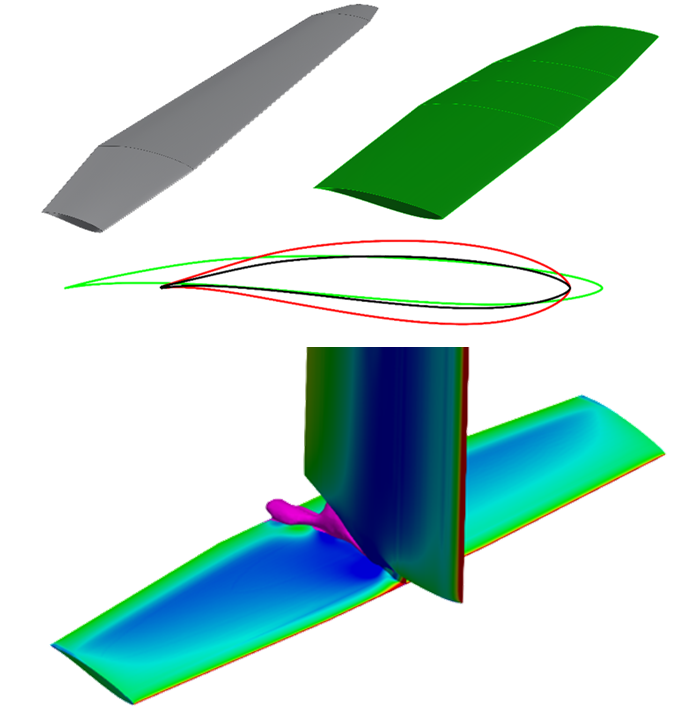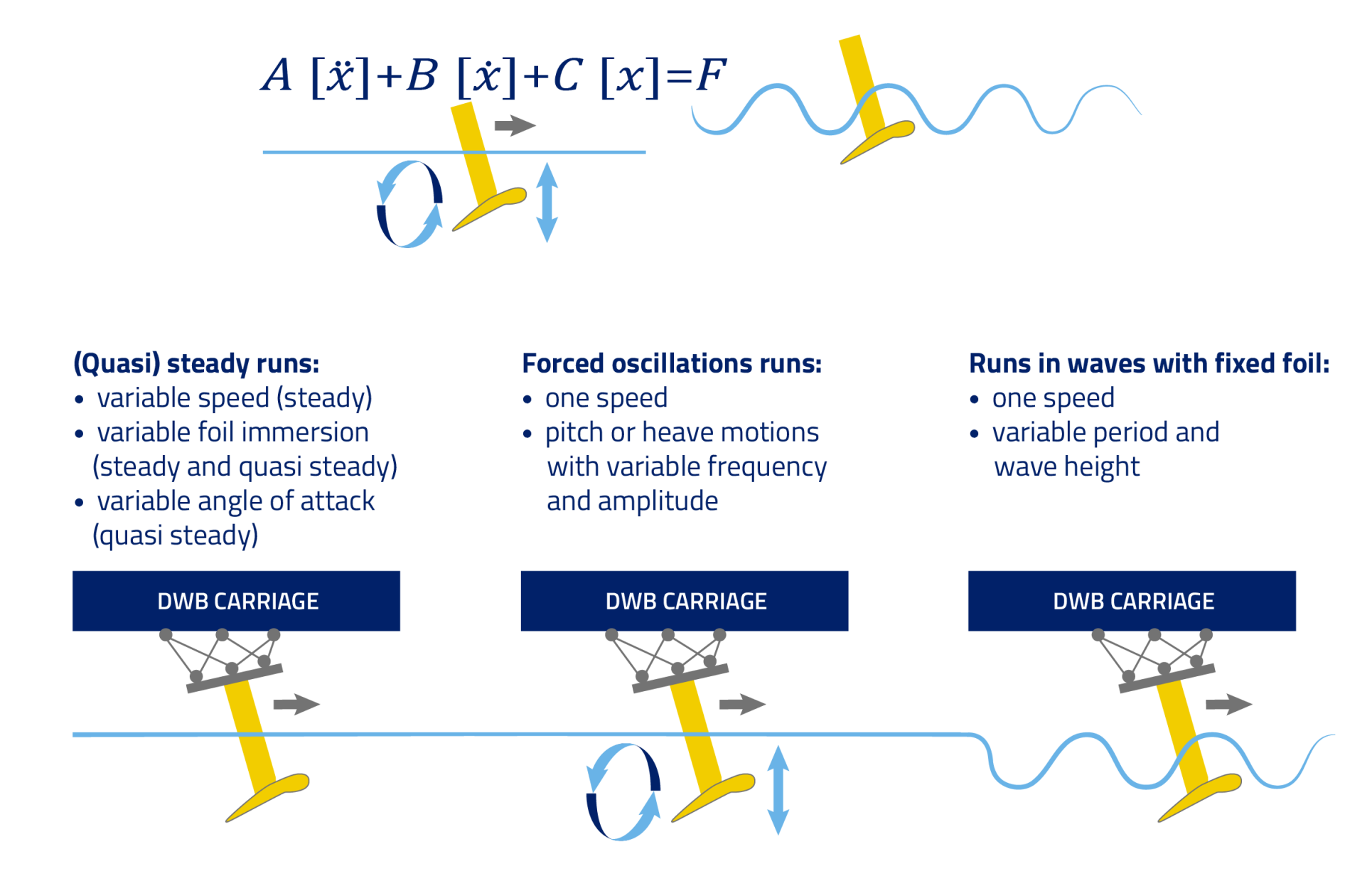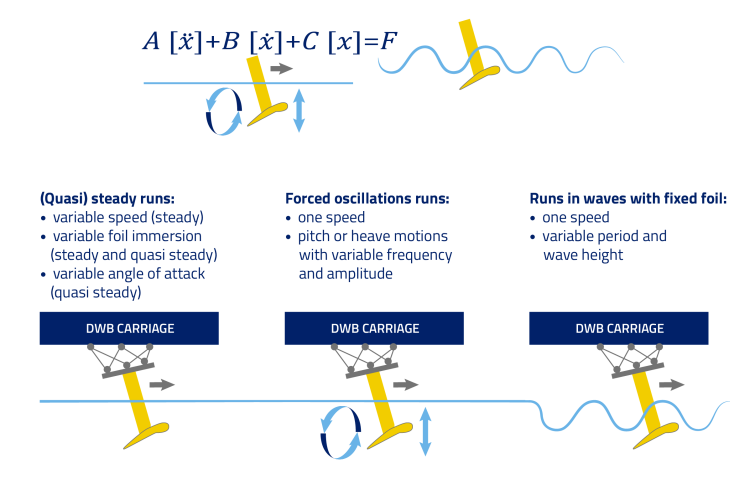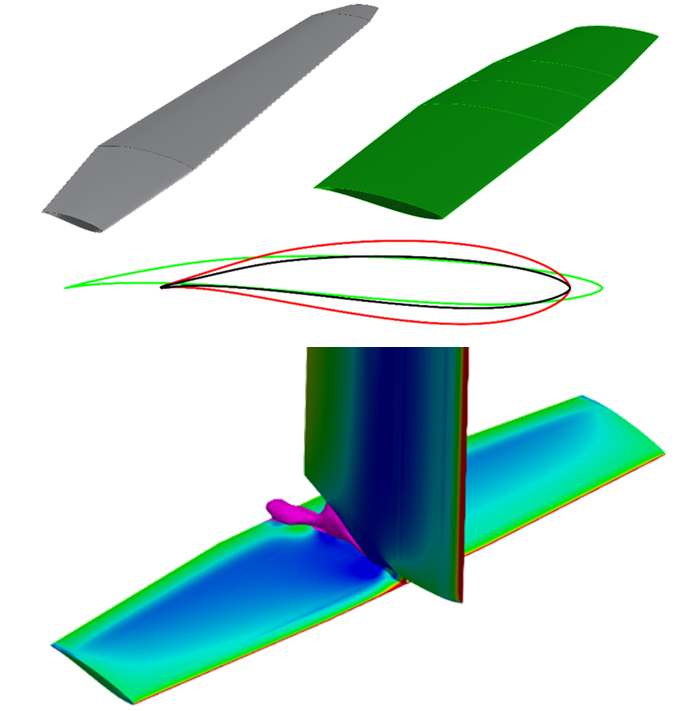June 2023, no. 136
News
BlueWeek
AI Sail
TopTier
CFD
Zero Emission
Foil Design
Traffic studies
F-series
Manxman ferry
Cover




Create a MARIN account to stay updated

Report
of foiling vessels
The Foil Design JIP is a research project focused on enhancing hydrodynamic knowledge for the early design phase of foiling vessels.
It specifically examines the performance of isolated hydrofoils in both steady and unsteady conditions, combining forced oscillation motions and free surface effects. The ultimate objective is to develop a preliminary design tool that provides comprehensive information on steady and unsteady foil characteristics, as well as relevant data for dynamic control system design.
The project consists of multiple work packages. The first completed package involved identifying representative applications of hydrofoil crafts and developing three initial hydrofoil geometries (figure 1) for experimental and numerical testing. Simultaneously, the groundwork and conceptualisation for the design tool was also laid.

Figure 1.
T-foil hydrofoils
A second work package focused on high fidelity investigations, employing model tests and RANS calculations to set the achievable fidelity level of the simulations. TU Delft performed model tests as an in-kind contribution to the JIP, while MARIN performed calculations. The test setup included three T-foil hydrofoils mounted on a force six-component frame connected to a hexapod. A dedicated actuation system enabled motions of the horizontal wing of the T-foil to change the angle of attack, while heave motions were actuated by the hexapod.
The matrix of investigated conditions revolved around the comprehensive analysis of hydrofoil forces, (lift and drag), not only in steady but also, showing the novelty aspect of this JIP, in unsteady conditions. In that respect, different types of runs (figure 2) were considered:
• quasi steady runs with the foil advancing at constant speed in calm water and varying immersion and/or angle of attack;
• forced sinusoidal oscillations of (uncoupled) pitch and heave while still advancing in calm water with multiple oscillations of amplitude and frequency;
• advance in waves (featured also by multiple combination of amplitude and frequency) with the foil at fixed angle of attack and speed.

Figure 2.
Scheduled for this year, the third work package aims to analyse and validate the results from RANS calculations and model tests. The data will form the foundation of a prediction/design tool, which will incorporate a prediction model trained using both RANS calculations and a low-fidelity vortex lattice method. This combination allows us to explore a wider design space of hydrofoils beyond the initial three investigated in the previous work packages.
Significant advancements
The Foil Design JIP currently involves eight participants from technical universities, shipyards, appendage suppliers and design studios. However, the project remains open to new participants who can contribute to this initiative.
With the project now in its second year, it is expected to be completed by January 2024. The collaborative efforts of all participants and the extensive research conducted will undoubtedly lead to significant advancements in hydrodynamic knowledge and contribute to the design and development of innovative foiling vessels.
The annual cooperation between MARIN and technical universities, including TU Delft (Hydro Motion Team) and TU Twente, will be reinforced to support students in designing hydrofoil craft powered by solar or hydrogen energy. The insight from the JIP can be utilised to aid the team in the initial design phase of these hydrofoils as well as all designers in their professional activity.
More info:

Hydrofoil Research
Previously published in SWZ, March 2023
swzmaritime.nl




Hydrofoil Research
Previously published in SWZ, March 2023
swzmaritime.nl
June 2023, no. 136
Report

More info:
Scheduled for this year, the third work package aims to analyse and validate the results from RANS calculations and model tests. The data will form the foundation of a prediction/design tool, which will incorporate a prediction model trained using both RANS calculations and a low-fidelity vortex lattice method. This combination allows us to explore a wider design space of hydrofoils beyond the initial three investigated in the previous work packages.
Significant advancements
The Foil Design JIP currently involves eight participants from technical universities, shipyards, appendage suppliers and design studios. However, the project remains open to new participants who can contribute to this initiative.
With the project now in its second year, it is expected to be completed by January 2024. The collaborative efforts of all participants and the extensive research conducted will undoubtedly lead to significant advancements in hydrodynamic knowledge and contribute to the design and development of innovative foiling vessels.
The annual cooperation between MARIN and technical universities, including TU Delft (Hydro Motion Team) and TU Twente, will be reinforced to support students in designing hydrofoil craft powered by solar or hydrogen energy. The insight from the JIP can be utilised to aid the team in the initial design phase of these hydrofoils as well as all designers in their professional activity.
Figure 2.
T-foil hydrofoils
A second work package focused on high fidelity investigations, employing model tests and RANS calculations to set the achievable fidelity level of the simulations. TU Delft performed model tests as an in-kind contribution to the JIP, while MARIN performed calculations. The test setup included three T-foil hydrofoils mounted on a force six-component frame connected to a hexapod. A dedicated actuation system enabled motions of the horizontal wing of the T-foil to change the angle of attack, while heave motions were actuated by the hexapod.
The matrix of investigated conditions revolved around the comprehensive analysis of hydrofoil forces, (lift and drag), not only in steady but also, showing the novelty aspect of this JIP, in unsteady conditions. In that respect, different types of runs (figure 2) were considered:
• quasi steady runs with the foil advancing at constant speed in calm water and varying immersion and/or angle of attack;
• forced sinusoidal oscillations of (uncoupled) pitch and heave while still advancing in calm water with multiple oscillations of amplitude and frequency;
• advance in waves (featured also by multiple combination of amplitude and frequency) with the foil at fixed angle of attack and speed.
Figure 1.

It specifically examines the performance of isolated hydrofoils in both steady and unsteady conditions, combining forced oscillation motions and free surface effects. The ultimate objective is to develop a preliminary design tool that provides comprehensive information on steady and unsteady foil characteristics, as well as relevant data for dynamic control system design.
The project consists of multiple work packages. The first completed package involved identifying representative applications of hydrofoil crafts and developing three initial hydrofoil geometries (figure 1) for experimental and numerical testing. Simultaneously, the groundwork and conceptualisation for the design tool was also laid.
The Foil Design JIP is a research project focused on enhancing hydrodynamic knowledge for the early design phase of foiling vessels.
of foiling vessels











